
 In this week's edition of Rewind Robert Smith takes a look back at the early career of Joe O'Brien, the man for whom the O'Brien awards are named. A number of old photos are featured.
In this week's edition of Rewind Robert Smith takes a look back at the early career of Joe O'Brien, the man for whom the O'Brien awards are named. A number of old photos are featured.
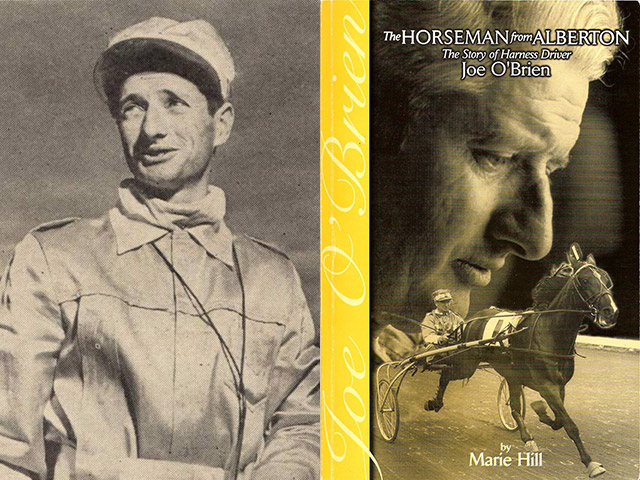
Left: Joe O'Brien shown during Old Home Week at Charlottetown in 1946. Right: the front cover of Marie Hill's book on Joe O'Brien
Canadian Harness Racing's most anticipated awards event of the year, The O'Briens, is once again upon us. This evening will see the finest the sport has to offer, all assembled in their finery at the Delta Meadowvale Hotel in Mississauga. Following dinner, speeches, awards, accolades, dancing and socializing will punctuate the evening. A precious few in the audience will carry home a treasured O'Brien trophy. While their monetary estimate is stated as $1,500, like most coveted awards in sports or otherwise, their value is without description or equal.
Almost lost in the process is the memory of the man for whom the awards are named: Joseph O'Brien. He passed away over 30 years ago on September 29th, 1984 at the age of 67 after a lengthy battle with cancer. It is quite possible one or more of this year's recipients were not yet born when Mr. O'Brien was still with us. I remember him well, but seeing his unmistakable 'figure' out on the track is as close as I ever got. A man I once worked with told me stories of playing 'hookie' from school and stealing away to watch him race at the many small town P.E.I. tracks near his home. That was during the 1930's.
Joseph Cyril O'Brien entered the world on Monday, June 25, 1917, the youngest of five sons and two daughters born to Harry and Jennie (Foley) O'Brien. Farming and racing harness horses was a part of the O'Brien family way dating back as long as they had inhabited Prince Edward Island. It was an obvious throwback to their roots in County Kilkenny, Ireland. Four of the five O'Brien sons pursued a career in the sport. In addition to Joe, brothers Claude, Raymond and Lloyd followed the horses. Only William, the eldest, remained on the sidelines. Sisters Doris and Agnes loved racing but only as fans of the family horses. Harry (whose actual name was Michael Joseph), the family's modern day patriarch was a pretty interesting man. He was a self-taught veterinarian, a fox farmer and a builder of racetracks to name just a few of his many talents.
At the age of three, "Little Joe" began his lengthy career amid the horses as he began to ride the tamer ones around the farm. By the age of seven, he started jogging along side his father and brothers. At 13, he won his first race with a horse named after then-famous hockey player Ace Bailey, a $40 purchase by his father. While most children his age followed other interests, the young O'Brien thought only of a career with horses.
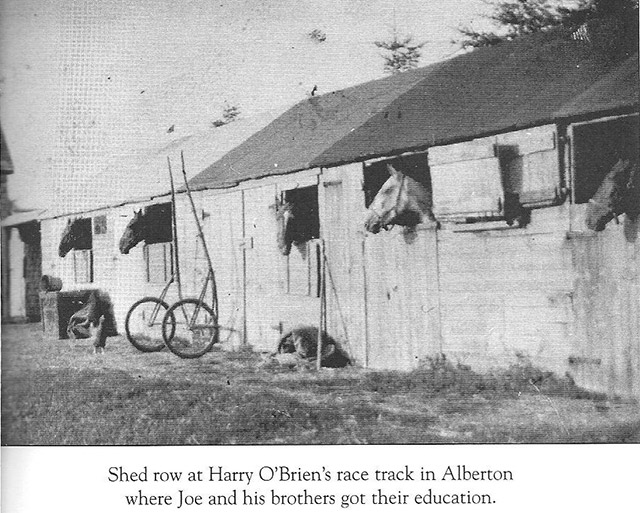
In 1936 William Latta, a horseman from a little place called River Hebert in Cumberland County, Nova Scotia wrote to Harry O'Brien to inquire if any of his sons might have an interest in becoming his trainer and driver for the coming year. According to legend, the senior O'Brien soon set about writing to Mr. Latta to notify him that none of his sons were even remotely interested in the offer of a job. Unbeknownst to him, young Joe -- who at the time was just 18 -- learned of the letter and took it upon himself to send a reply; and his note was short but in the affirmative.
After much persuasive talking and resultant advice from his father to stay home, Joe decided to take the job. Unwilling to admit that he had absolutely no money (some accounts say he had $6 in his pocket) when confronted by his father, Joe simply stated, "Got all the money I need..." In reality what happened was a small 'loan' from his brother Claude, 10 years his senior, and off he went.
A trip of 250 miles by ferryboat and train ensued and his eventual arrival at the tiny hamlet of River Hebert, a place where French was the native tongue. With no one there to greet him, a walk of three miles through a wet and muddy countryside finally ended at the Latta farm and stables. Upon arrival, he found Mr. Latta ill in bed and in a generally foul mood. At the top of his 'list' of complaints was that he had no idea he was hiring someone so young and secondly so small in stature. Bear in mind that at the peak of his adulthood, Joe O'Brien was a mere 5'6" and weighed but 135 pounds, a size he had yet to attain.
Once the preliminary grumbling had passed, Mr. Latta was resigned to the facts and told the young gentleman he might as well set about the task at hand. The stable consisted of five horses, all full brothers and sisters, and only one broken to harness. After nearly being trampled by the first horse he took out of the stall, the young lad took matters into his own hands and soon had all of the horses into a training routine. By the time the Maritime summer racing season had opened, the O'Brien - Latta combination had started to click. At season's end, O'Brien followed the sale of a couple of Latta Stable members and joined another outfit racing in the region.
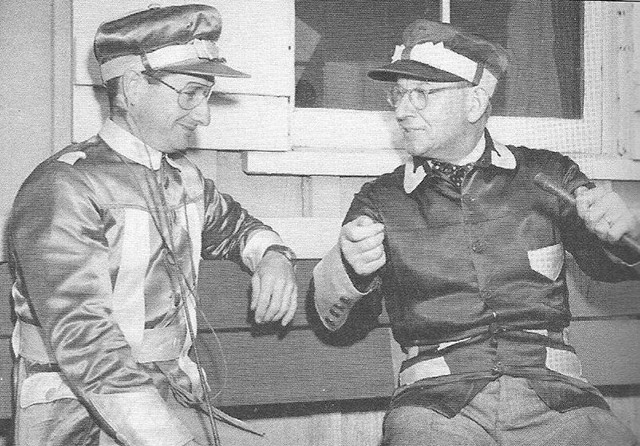
A young Joseph O'Brien chats with legendary European horseman Charlie Mills who raced mainly in Germany
From here began one of the greatest 'trips' ever taken by a harness horseman. After several years of racing on home turf and and an extremely humble beginning, Joe O'Brien made has way across the border and tried his hand on a bigger circuit. In 1947, he was the leading driver at Foxboro, Mass. Soon his talents were noticed on a larger scale and an invitation to become the second trainer for famed horseman Sep Palin came his way. At this time that was the path to follow for success. In 1948 he made the cross-Continental journey to California to Palin's winter quarters. While this was not an immediately successful move, it soon paved the way to several decades at the absolute Top of the sport.
In 1952 a wealthy California man named Sol Camp took a liking to O'Brien and hired him as head trainer and driver. He began supplying him with an abundant group of very well-bred horses. From the likes of Diamond Hal and Scott Frost came a highly successful operation. When Mr. Camp died just a few years later, his widow and son carried on and more successes followed. From here came many more patrons and around 1963 the famed up and coming Armstrong Bros.' joined forces with O'Brien. The names of Armbro Flight, Governor Armbro and Horton Hanover emerged from this time period. His list of records set, money earned, famous races won and horses driven has been captured in a couple of books of note.
The Long Journey
Unlike the most successful drivers of today, in Joe O'Brien's era to make it you broke and trained a lot of horses. At the peak of his 'glory years', he operated a 90-acre farm at Shafter, California and on it stood stabling for 100 horses. Most often the stalls were full. In most cases he had personally selected each horse based on his vast knowledge and his advice was often sought even by other owners. Additionally each year at Lexington when time trials were held, O'Brien literally jumped from one mount to the next as his uncanny talents for rating a horse made him the busiest man at The Red Mile.

A quartet of famous drivers are pictured here undoubtedly engaged in a rather light-hearted moment. From left: Joe O'Brien, Keith Waples ,Wm. Haughton and Delvin Miller.
A great deal of Mr. O'Brien's career preceded the era of huge purses and year round racing. For example available statistics show that in 1946, right after WW II, he earned a total of $8,682 that season while recording 83 wins. Twenty years later in 1966 he chalked up 165 wins and his stable took home $730,445. His career wins are recorded as 4,285 which at the time of his passing placed him sixth all time. Needless to say the comparison of statistics across eras is a difficult measure and quickly pass out of relevance.
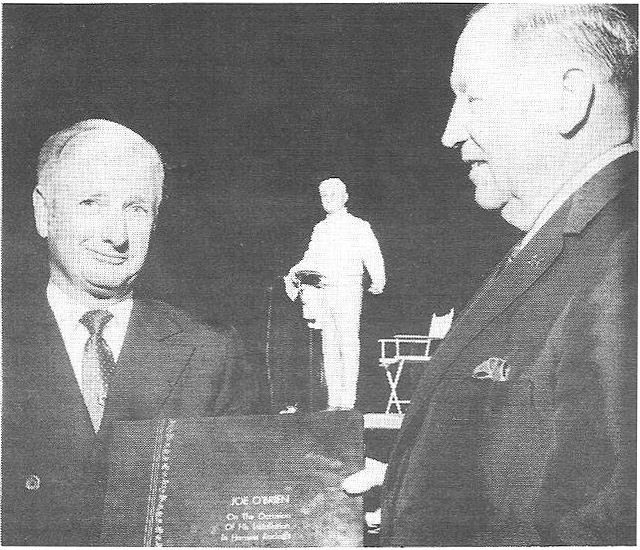
C.T.A. President Allen Dickenson presents the HOF book to Mr. O'Brien at his induction in 1979
From the small dusty tracks of Prince Edward Island and other Maritime locales emerged not only a great horseman but an equally fine and upstanding man. From a time when a few dollars was considered a successful day's work to the pomp and frills of winning races like The Little Brown Jug and The Hambletonian came Joseph O'Brien, the ultimate professional. The decision to name Canada's top awards after him was a fitting choice and one that will surely stand the test of time. It is based on his overall superb combination of talent, endurance and lifetime dedication to his chosen profession.
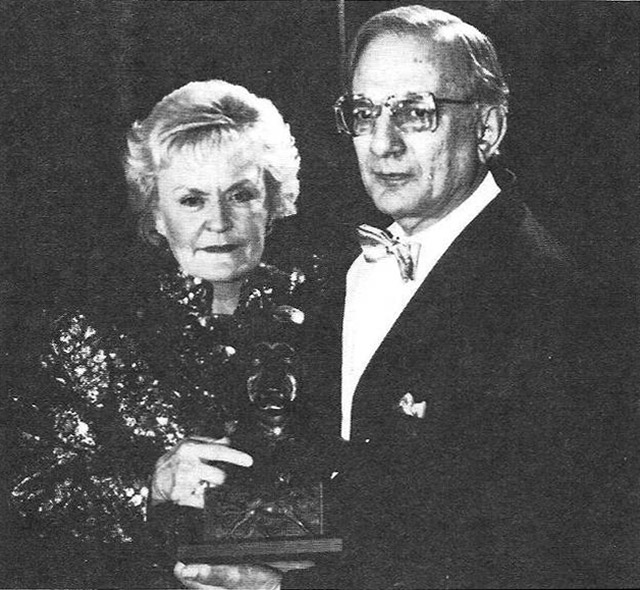
The first ever O'Brien award was presented in January 1989 to Ilene O'Brien, widow of Joe O'Brien. The presenter is Stan Bergstein, a long-time close friend of the O'Briens

